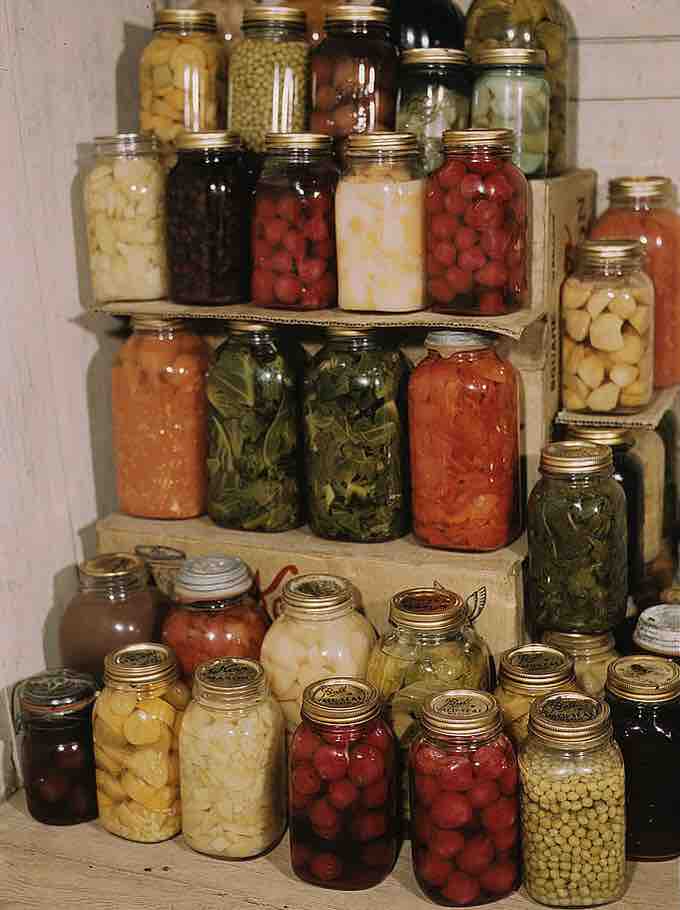Food Preservation
Food preservation is the process of treating and handling food to stop or slow down food spoilage, loss of quality, edibility, or nutritional value and thus allow for longer food storage.
Preservation usually involves preventing the growth of bacteria, fungi (such as yeasts), and other microorganisms, as well as retarding the oxidation of fats which cause rancidity.
Methods of Food Preservation
A number of methods of prevention can be used that can either totally prevent, delay, or otherwise reduce food spoilage. Preservatives can expand the shelf life of food and can lengthen the time long enough for it to be harvested, processed, sold, and kept in the consumer's home for a reasonable length of time.
Maintaining or creating nutritional value, texture and flavor is an important aspect of food preservation, although, historically, some methods drastically altered the character of the food being preserved. In many cases these changes have now come to be seen as desirable qualities, as with cheese, yogurt, and pickled onions.
Drying is one of the most ancient food preservation techniques, which reduces water activity sufficiently to prevent bacterial growth.
Refrigeration preserves food by slowing down the growth and reproduction of microorganisms and the action of enzymes which cause food to rot.
Freezing is also one of the most commonly used processes for preserving a very wide range of food including prepared foodstuffs which would not have required freezing in their unprepared state.
Vacuum-packing stores food in a vacuum environment, usually in an air-tight bag or bottle. The vacuum environment strips bacteria of oxygen needed for survival, thereby slowing spoiling. Vacuum-packing is commonly used for storing nuts to reduce the loss of flavor from oxidation.
Salting or curing draws moisture from the meat through a process of osmosis. Meat is cured with salt or sugar, or a combination of the two. Nitrates and nitrites are also often used to cure meat and contribute to the characteristic pink color, as well as inhibition of Clostridium botulinum.
Sugar is used to preserve fruits, either in syrup with fruit such as apples, pears, peaches, apricots, plums, or in crystallized form where the preserved material is cooked in sugar to the point of crystallisation and the resultant product is then stored dry. This method is used for the skins of citrus fruit (candied peel), angelica, and ginger. A modification of this process produces glacé fruit such as glacé cherries where the fruit is preserved in sugar but is then extracted from the syrup and sold, the preservation being maintained by the sugar content of the fruit and the superficial coating of syrup. The use of sugar is often combined with alcohol for preservation of luxury products such as fruit in brandy or other spirits. These should not be confused with fruit flavored spirits such as cherry brandy.
Smoking is used to lengthen the shelf life of perishable food items. This effect is achieved by exposing the food to smoke from burning plant materials such as wood. Most commonly subjected to this method of food preservation are meats and fish that have undergone curing. Fruits and vegetables like paprika, cheeses, spices, and ingredients for making drinks such as malt and tea leaves are also smoked, but mainly for cooking or flavoring them. It is one of the oldest food preservation methods, which probably arose after the development of cooking with fire.
Preservative food additives can be antimicrobial. These inhibit the growth of bacteria or fungi, including mold, or antioxidant, such as oxygen absorbers, which inhibit the oxidation of food constituents. Common antimicrobial preservatives include calcium propionate, sodium nitrate, sodium nitrite, sulfites (sulfur dioxide, sodium bisulfite, potassium hydrogen sulfite, etc.), and disodium EDTA. Antioxidants include BHA and BHT. Other preservatives include formaldehyde (usually in solution), glutaraldehyde (kills insects), ethanol, and methylchloroisothiazolinone.
Pickling is a method of preserving food in an edible anti-microbial liquid. Pickling can be broadly categorized into two categories: chemical pickling and fermentation pickling.
Canning involves cooking food, sealing it in sterile cans or jars, and boiling the containers to kill or weaken any remaining bacteria as a form of sterilization . Foods have varying degrees of natural protection against spoilage and may require that the final step occur in a pressure cooker. High-acid fruits like strawberries require no preservatives to can and only a short boiling cycle, whereas marginal fruits such as tomatoes require longer boiling and addition of other acidic elements. Low acid foods, such as vegetables and meats require pressure canning. Food preserved by canning or bottling is at immediate risk of spoilage once the can or bottle has been opened.

Preserved Food
Canning food is one method of food preservation.
Other forms of preservation can include: jellying, jugging, irradiation, pulsed electric field processing, modified atmosphere, high pressure, burial in the ground, and biopreservation.